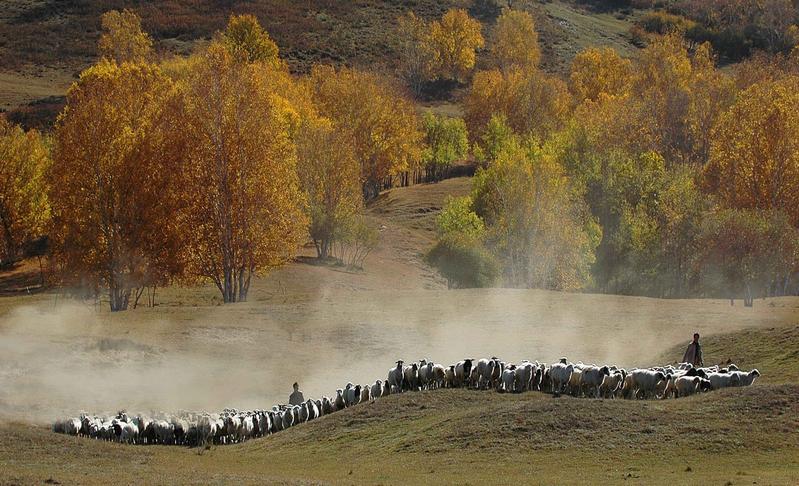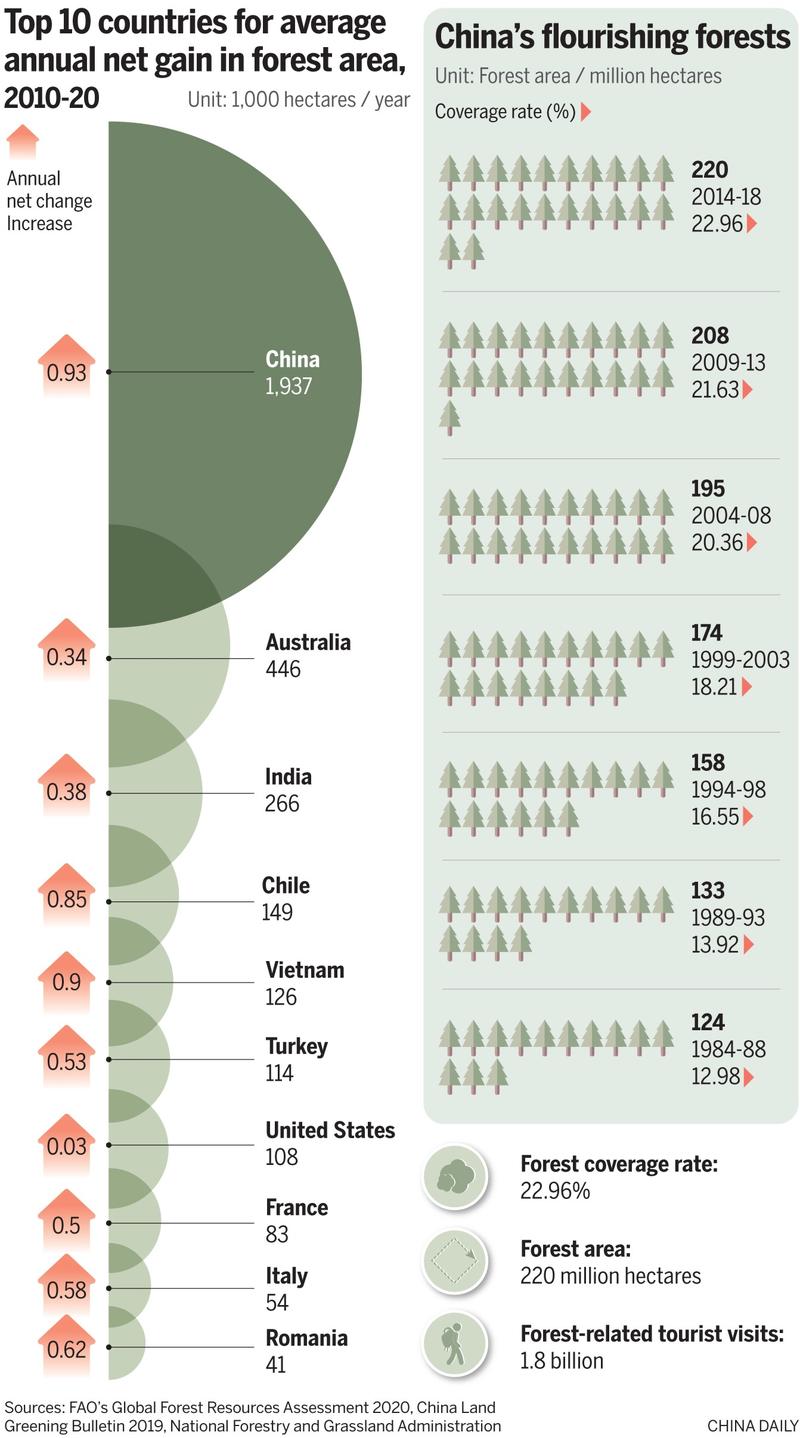 In this undated photo, sheep graze at Saihanba National Forest Park in Chengde, Hebei province. (PAN ZHENGGUANG / XINHUA)
In this undated photo, sheep graze at Saihanba National Forest Park in Chengde, Hebei province. (PAN ZHENGGUANG / XINHUA)
Six years ago, a door slammed shut for Sun Xueshui and tens of thousands of other loggers and timber mill workers in northeastern China's Heilongjiang province.
For generations, they and their ancestors had felled and processed trees for meager wages among the Greater Hinggan Mountains in the forest-rich province, a stronghold of China's sprawling network of State-owned forest farms.
However, the province banned commercial logging in natural forests in 2014 in an attempt to find a greener path for forest farms, which include both natural forests and plantations.
ALSO READ: China releases 15-year plan for ecological protection
Shortly after the ban was introduced, the Qianshao Forest Farm, Sun's employer, opened another door for its workers.
It refrained from sacking them, despite the massive loss of timber revenue, and instead shifted Sun and his colleagues to new posts on lower salaries as forest rangers patrolling for forest fires and pests.
To make up for the shortfall, the farm allowed staff members to start businesses as a sideline, hoping they would receive a financial boost by tapping other forest resources in an environmentally friendly way.
Building an ecological civilization is a major task for China as it has grown prosperous and is becoming strong, Xi said, calling for a solid "Green Great Wall" to protect the environment
For Sun, this was through collecting and processing wild mushrooms, which are abundant in the region, as he sought to profit from the nation's growing enthusiasm for organic food.
But as the supply of wild mushrooms was constrained by seasonal factors, Sun then saw a business opportunity in the mountain springs that flow freely in the forests. In 2018, he set up a distillery that makes baijiu-a Chinese liquor-at a small facility offered by the farm free of charge. Sun said that he uses spring water and rice, a local specialty, as raw materials, unlike local competitors who commonly use corn.
His brainchild is now a lucrative business and the expansion of the distillery last year lifted its annual production capacity to 10,000 liters.
"We're planning to hire more hands," said Sun, 46, who started working as a lumberjack in 1990."We'll first consider my fellow workers at the farm who have been in financial difficulties."
In addition to the distillery, the farm built 140 greenhouses for growing edible mushrooms, hiring about 150 former lumberjacks. Wei Ranbao, a farm official overseeing the project, said the greenhouses had raised farm employees' per capita income by some 3,400 yuan (US$492) a year in 2014. They now earn about 50,000 yuan a year.
The successes at Qianshao have set an example for more than 4,800 State-owned forest farms scattered across China as they attempt to shift their focus from the exploitation of forests' timber resources to their preservation, in line with government policies.
They also showcase the potential for forest resources to be used in greener ways, in line with the maxim "lucid waters and lush mountains are invaluable assets", which was put forward by President Xi Jinping in 2005, when he was Party secretary of Zhejiang province.
The forest farm reforms that started in Heilongjiang six years ago are part of a broader effort by the central authorities to revitalize the economies of former heavy industrial bases in northern and northeastern provinces that have lost steam due to the gradual depletion of oil deposits and other natural resources.
During a 2016 visit to Yichun, an area of dense forests in Heilongjiang, Xi, who is also general secretary of the Communist Party of China Central Committee and chairman of the Central Military Commission, stressed the significance of environmental protection and demanded concerted efforts to establish new industries other than logging.
In Beijing last year, he told legislators from northern China's Inner Mongolia autonomous region that strategic resolve was needed when it came to building an eco-friendly economy. He described the protection of the country's environment as being embedded in China's overall development strategy, and highlighted its particular relevance to the development of Inner Mongolia.
The forest farm reforms are also considered a crucial move in bolstering the ecological security of border regions as the country ramps up efforts to conserve its environment and build a "beautiful China", an idea first put forward in late 2012.
At a forest farm in Chifeng, Inner Mongolia, last year, Xi said that building an ecological security barrier in northern China was a strategic task. While visiting an afforestation area in the northwestern province of Gansu last year, he called for a spirit of perseverance and sustained efforts in building a beautiful China.
Building an ecological civilization is a major task for China as it has grown prosperous and is becoming strong, Xi said, calling for a solid "Green Great Wall" to protect the environment.
Ecological barrier
To meet the demand for timber as the newly founded People's Republic of China embarked on an industrialization drive, the CPC looked to the lush Greater Hinggan Mountains for answers in the 1950s.
Armies of urban youth, soldiers, workers and officials were deployed to the region in the following decades to bolster the production of timber-crucial to the construction of railways and other infrastructure in the then largely rural country. Many settled down, forming new cities.
The massive project fueled China's rapid industrialization by providing more than 200 million cubic meters of timber and tens of billions of yuan in tax revenue by 2015, Xinhua News Agency reported, citing local authorities.
However, decades of unchecked human activity damaged vast swaths of formerly virgin forests and wetlands in the area, which serve as an ecological barrier against cold air sweeping down from Siberia and dry winds blowing from the Mongolian plateau. The region is also home to the headwaters of several important rivers, including the Heilong River, the country's third-longest, on the border with Russia.
According to the Global Forest Resources Assessment 2020 issued by the UN Food and Agriculture Organization, China had the world's best average annual net gain in forest area in the past decade at 19,370 sq km
The damage reached a crescendo in 1987, when a fire believed to have been caused by a careless worker destroyed more than 10,000 square kilometers of forest among the rolling mountains and killed hundreds of people. Direct economic losses were calculated at 500 million yuan.
The fire, and deadly floods that wreaked havoc in the Yangtze River and Songhua River basins in 1998, shone a spotlight on the ecological cost of China's decadeslong forest development plans and prompted the authorities to take action.
In 1998, China launched the Natural Forest Preservation Project in a dozen regions including Heilongjiang and neighboring Jilin province. It was later expanded nationwide, leading to a considerable reduction in logging in natural forest zones.
READ MORE: Report: China contributes to global ecological protection
The following year, the central authorities introduced another multibillion-yuan program to return cropland to forest and grassland. Costing 500 billion yuan up to last year-two-and-a-half times as much as the Three Gorges Dam, the world's largest hydroelectric project-the ongoing program is the world's most expensive ecological project, the then head of the National Forestry and Grassland Administration, Zhang Jianlong, said last year at a news conference marking its 20th anniversary.
The push for greener development was reinforced in 2012, when the Party added environmental preservation to its blueprint for the overall construction of a socialist society. It had previously listed four sectors: the economy, politics, culture and civil society.
The programs will reap benefits in the decades to come, cementing the nation's ambition to raise forest coverage to 26 percent by 2035, and catch up with the global average of 31 percent by the middle of the century.
READ MORE: Grassland aids nation’s green development drive
The total area of China's forests increased by almost 130,000 sq km between 2014 and 2018, according to the ninth survey of national forest resources published last year. That has boosted China's forest coverage rate to 22.96 percent, 1.33 percentage points higher than in 2014.
According to the Global Forest Resources Assessment 2020 issued by the UN Food and Agriculture Organization, China had the world's best average annual net gain in forest area in the past decade at 19,370 sq km.

In 2017, an afforestation project in Saihanba, Hebei province, won the UN Environment Program's Champions of the Earth award. The area used to be a lush imperial hunting ground, but turned into a sprawling desert due to decades of excessive logging, fueling sandstorms across North China. The restoration project, which started in the 1960s, eventually turned the desert into a national forest park.
Lumberjack homestays
Heilongjiang's timber output peaked at 15.7 million cubic meters in 1978, but plummeted to 894,000 cubic meters in 2013, before the ban on commercial logging in natural forests was introduced.
READ MORE: Logging to be prohibited in natural forests
The ban was extended nationwide in 2015, and the National Forestry and Grassland Administration said the timber output from major forest farms across China dropped by an annual average of 3.73 million cubic meters in the three years to the end of 2017.
The extension of the ban saw more forest farms roll out aid to employees as they put down their chain saws and picked up other trades.
One such employee was Gu Changyun, from a picturesque logging town in Arxan, Inner Mongolia, which lies to the southwest of the Greater Hinggan Mountains.
Born into a lumberjack family, Gu joined the local forest farm in 1990. As the logging mainly took place in the coldest months-when the soil is frozen solid, making it easier to drag out felled trees-she has chronic rheumatism.
"We would depart in the early hours and return home in darkness," said Gu, 48, a widow whose 26-year-old son is a migrant worker in southwestern China's Sichuan province.
"We would take steamed buns for meals, and put them close to the skin to keep them warm."
In recent years, local authorities developed workshops that make tourism souvenirs using birch bark. Gu was among the 45 impoverished workers to benefit. She joined the project two years ago, and now earns 2,000 yuan a month.
Some of her neighbors became self-taught tour guides after the local government built lumberjack-themed homestays reminiscent of life in the area in the 1950s.
Han Zhongyong, who oversees the project, said it had boosted the construction of roads and water, heating and drainage infrastructure.
To make up for the shortfall in timber output, China launched an initiative in 2018 to increase the number of plantations to boost usable timber reserves.
Six regions have been designated for the development of timber reserve forests, including coastal regions in southeastern China, the middle and lower reaches of the Yangtze River, and the Beijing-Tianjin-Hebei cluster, the National Forestry and Grassland Administration said in a circular issued four years ago.
Contact the writers at lilei@chinadaily.com.cn


